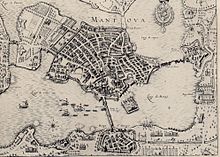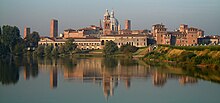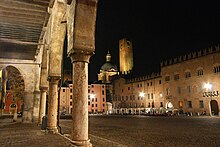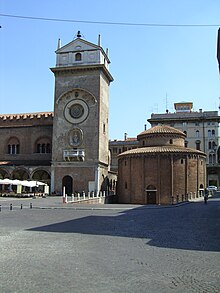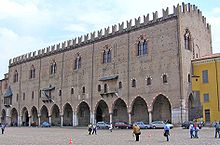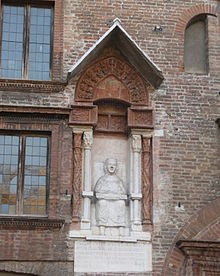Mantua
Mantua (in Italian Mantova) is an Italian city located in the region of Lombardy, capital of the homonymous province. It is surrounded on three sides by the Mincio River. Agricultural and tourist center, it has factories that produce agricultural machinery, fertilizers, furniture, footwear and toys. It is the setting for the opera Rigoletto. Mantua was named the capital of Italian culture in 2016.
History
Mantua was founded, according to myth, by Ocnos, son of Manto (daughter of Tiresias), who named the city after his mother. In reality, Mantua was founded by the Etruscans, and later conquered by the Romans. The name derives from the Etruscan god Mantus, from arid Hades. After being conquered by the Cenomani, a Gallic tribe, the city was again conquered by the Romans between the First and Second Punic Wars. The territory was populated by veteran soldiers of Octavio Augusto, its most famous citizen being the poet Virgil.
After the fall of the Roman Empire, it was invaded by the Byzantines, the Lombards and the Franks. In the 11th century it became the possession of Boniface of Canossa, Marquis of Tuscany. The last ruler of the family was the Countess Matilda de Canosa, who died in 1115, who, according to legend, ordered the construction of the beautiful Rotonda di San Lorenzo (1082).
After the death of Mathilda of Canosa, Mantua became a free commune, defending itself staunchly against the Holy Roman Empire for centuries XII and XIII. In 1198 Alberto Pitentino optimized the course of the Mincio, creating what the Mantuans called the four lakes to reinforce the natural protection of the city. Between 1215 and 1216 the city came under the podesteria of the Guelph Rambertino Buvalelli.
During the struggle between the Guelphs and the Ghibellines, Pinamonte Bonacolsi took advantage of the chaotic situation to seize power in 1273. His family ruled Mantua for the next century, making it more prosperous and artistically beautiful. On August 16, 1328, the last Bonacolsi, Rinaldo, was defeated in a revolt supported by the Gonzaga, a family of officers. The city prospered under the rule of the Gonzaga family (1328-1708). The Gonzagas built new walls with five gates and renovated the city's architecture in the XIV century, but the political situation of the The city was not settled until the third Gonzaga, Luis II Gonzaga, who eliminated his relatives, seizing all power. In 1459 Pope Pius II held a diet in Mantua to proclaim a crusade against the Turks. The famous Renaissance painter Andrea Mantegna worked with Francis II in Mantua as a court painter, producing some of his most outstanding works. The first Duke of Mantua was Federico II Gonzaga, who acquired the title from Emperor Charles V in 1530.
Composer Claudio Monteverdi worked for the Gonzagas in the Duchy of Mantua from 1590 to 1613. In 1627, the direct line of the Gonzaga family dried up with the vicious and weak Vincent II and the city gradually declined under new rulers, the Gonzaga-Nevers, a minor French branch of the family. The War of the Mantuan Succession broke out and in 1630 an imperial army of 36,000 mercenary lansquenets besieged and sacked Mantua on 18 July, bringing with them the plague. Mantua never recovered from this disaster.
Fernando Carlos IV, an inept ruler whose only pretension was to celebrate parties and theatrical performances, allied with France in the War of the Spanish Succession. After the defeat of the second, he took refuge in Venice, taking with him a thousand paintings. On his death in 1708, he was declared deposed and his family lost Mantua forever to the Austrian Habsburgs.
Mantua was ruled by Austria from 1708 to 1866, except from 1797 to April 27, 1814, when it came under French influence in Napoleonic times. Under Austrian rule, Mantua enjoyed a renaissance and during this period, the Royal Academy of Sciences, Letters and Arts, the Scientific Theater and numerous palaces were created. On June 4, 1796, during the Napoleonic Wars, Mantua was besieged by Napoleon as a move against Austria, who joined the First Coalition. Austrian and Russian attempts to break the blockade failed but succeeded in driving the French to abandon the siege and fight on other battlefields on 31 July. They returned on August 24. At the beginning of February the city surrendered and the region was placed under French administration. Two years later, in 1799, the city (Siege of Mantua (1799)) was reconquered by the Austrians. The city then reverted back to Napoleon's control. In the year 1810 Andreas Hofer was shot near the Porta Giulia, a city gate in Borgo di Porto (Cittadella); he had led the Tyrolean insurrection against Napoleon.
Following brief French rule, Mantua returned to Austrian hands in 1814, becoming one of the Quadrilatero fortress cities in northern Italy. In 1866, Mantua was incorporated into unified Italy by the King of Sardinia.
Monuments and places of interest
Among its monuments it is worth noting the Palazzo Ducale with frescoes by Andrea Mantegna, whose tomb is in Sant'Andrea, a basilica that began to be built in the XV, together with the church of San Sebastiano, both according to Alberti's designs. The Magna Domus, the Palazzo del Capitano, the Palazzo Vescovile, the Palazzo degli Uberti, the Castle of Saint George, the Palazzo Castiglioni (or Palazzo Bonacolsi), the Gabbia Tower, and the Palazzo del Podestà, all of them examples of heritage in patrician buildings and Italian architecture.
We must also highlight the Cathedral of Saint Peter the Apostle built by Giulio Romano (1545) and Palazzo Tè (1525-1535), symbol of the city, also designed and decorated by Giulio Romano (who lived in Mantova in his last years), made as a residential villa for Federico II Gonzaga, in an advanced Renaissance style and with certain touches of post-Raphaelian mannerism. It houses the civic museum.
In 2008 it was registered as a World Heritage Site by Unesco, together with Sabbioneta, for representing both different aspects of Renaissance urban planning. Specifically, Mantua shows the renewal and existence of a pre-existing city, with an irregular scheme with regular parts that show the different stages of its growth, from the time of the Romans, to the Renaissance, through the Middle Ages. Mantua, like Sabbioneta, offers exceptional testimony to the artistic, architectural and urban achievements of the Renaissance, brought together through the visions and actions of the Gonzaga family.
Religious architecture
- Cathedral of Saint Peter (Duomo)
- dedicated to Saint Peter, the present duomo in Romanesque style with Gothic additions, was built between 1395 and 1401 after a fire, centuries before, destroyed a previous paleo-Christian temple. It was renovated in 1545 by 1545 da Giulio Romano, who left the facade intact but changed the form, inspired by the first paleo-Christian basilicas. The current facade, of marble of Carrara, dates from 1761. The side has Gothic inserts such as rosettes, cuspides and pinnacles, remains of the old facade. In the interior you can admire the craftsmanship that dominates the three naves: the main one is decorated with statues of Sibilas and prophets dating from the sixteenth century. The incorrupt body of Sant'Anselmo da Baggio is preserved under the main altar. The Cathedral, located in the monumental Sordello Square, is the obispado of Mantua.
- Basilica of Saint Andrew
- designed by Leon Battista Alberti, was built from 1472 and was completed 328 years later with the construction of the dome based on designs by Filippo Juvarra. In the crypt is kept inside the Sacri Vasi relic of the Beautiful Blood of Christ taken to Mantua by the Roman centurion Longino. In one of the chapels is preserved the funeral monument of Andrea Mantegna, presided over by the bronze effigy of the painter of the court of the Gonzaga.
- Basilica palatina de Santa Barbara
- church of the court of the Gonzaga loved by the Duke Guglielmo who commissioned the project to the Lithuanian architect, Giovan Battista Bertani. An integral part of the Ducal Palace, the construction of the church was completed in 1572.
- Rotonda de San Lorenzo
- is the oldest church in the city, built in the eleventh century during the domination of the Canossa. From a round central plant, the Rotonda di San Lorenzo is at a lower level than the Plaza delle Erbe and preserves in its interior a matroneo and traces of frescoes from the Byzantine school dating from the XI-XII centuries. Over the centuries he suffered radical transformations; he became deacralized, so much that at the beginning of the 20th century he was embedded in successive buildings after his construction. Expropriated in 1908, the San Lorenzo roundabout was restored and reopened in
- Church of San Sebastian
- started 1460 by Luca Fancelli according to Leon Battista Alberti project, was completed in 1529. Unknown in the eighteenth century, it was used for various purposes until 1925 when, after a questionable restoration that added the two entrance stairs, it became the fame of the fallen Lithuanians of all wars.
- Synagogue Norsa Torrazzo
- was moved and rebuilt faithfully in its current location, when the demolition of the Jewish quarter was decided between 1899 and 1902.
- Episcopal Seminar
- the building, located next to the Duomo in Via Fratelli Cairoli, was renovated in 1825 in a neoclassical style as can be seen in particular in the facade and in the inner courtyard.
- Church of Sant'Apollonia – via Benzoni 20
- Church of San Barnaba – piazza Bazzani
- Church of San Cristoforo – via Acerbi
- Sant'Egidio Church – via Frattini
- Church of San Francesco – piazza San Francesco d'Asisi 5
- Chiesa dei Santi Gervasio e Protasio – via Trento 1
- Church of San Leonardo – piazza San Leonardo
- Chiesa della Madonna del Terremoto – piazza Canossa
- Church of Santa Maria della Carità – via Corridoni 33
- Church of Santa Maria del Carmine – vicolo Carmine
- Church of Santa Maria del Gradaro – via Gradaro
- Santa Maria della Vittoria Church – via Fernelli
- Church of San Martino – via Pomponazzo
- Church of San Maurizio – via Chiassi
- Church of Ognissanti – Corso Vittorio Emanuele
- Church of Sant'Orsola – Corso Vittorio Emanuele 53
- Church of Santa Paola – piazza dei Mille
- Chiesa dei Santi Simone e Giuda – via Fernelli
- Church of Santo Spirito – via Vittorino da Feltre
- Church of Santa Teresa – via Mazzini
- Church of Santa Caterina – Corso Garibaldi
- Church of San Giuseppe Artigiano – via Indipendenza
- Church of Santa Maria degli Angeli – via della Certosa (Borgo Angeli)
- Church of San Filippo Neri – via Pasquale Miglioretti (Borgochiesanuova)
Disappeared religious buildings
- Church delle Quarant'ore
- Church of San Domenico
- Church of Sant'Agnese
- Church of Santa Maria di Capo di Bove
- Oratorio de Santa Maria del Melone
Civil architecture
- Ducal Palace
- Perhaps it is more correct to speak of "città-palazzo", since the architectural set is formed by numerous buildings connected by corridors and galleries, and enriched by internal courtyards, some pendants and large gardens. The reggia of the Gonzaga, by extension of the roofs, is the second in Europe only surpassed by the Vatican. It does not seem improper to define the Gonzaga palace as the Palazzi Ducaligiven the custom of almost all dukes to build their own residence that adds to what was previously built. Even before the arrival of the Gonzaga, the first nuclei of the palace had been built, but the history of the ensemble is mainly identified with that of the family that ruled the city until 1707. Among others, celebérrima is the so-called Camera degli Sposi (Camera picta) in the castle of San Giorgio, part of the "città-palazzo", painted fresh by Andrea Mantegna and dedicated to Ludovico III Gonzaga and his wife Barbara of Brandenburg. Once Mantua became Austrian, the renovations continued until the second half of the eighteenth century thanks to the governors sent by the emperor.
- Palace of Tea
- It is a work by Giulio Romano who in 1525 designed it on behalf of the Marquis Federico II Gonzaga who used it for his leisure. He made the "official" lover Isabella Boschetti reside in him. Il "Palazzo dei lucidi inganni" was in the center of an island full of forests and surrounded by the waters of a lake, now drained: mysterious, full of symbols and myths that stand out in the beautifully painted rooms fresh by Giulio Romano himself, like the celebérrima Sala dei giganti and the one of Amore e Psiche and, lastly, the hall of the Cavallis
- Palacio della Ragione
- it was built when it was podestà Guido da Correggio (1242), at the time comunale, with public functions and to allow assemblies and meetings of the city. On the ground floor the building housed, as now, numerous shops, while in the large upper floor hall justice was administered. On the walls of this room you can see remains of medieval frescoes of the late twelfth and thirteenth century recently restored. This room is accessed through a steep staircase located under the Torre dell'Orologio erected in the 15th century, period to which the arches that give to the Piazza Erbe also go back. The Palace is now used as an exhibition site that houses art exhibitions organized by the Comune di Mantova.
- Palacio Bonacolsi (Castiglioni)
- is located in Piazza Sordello, was built by Pinamonte Bonacolsi towards 1272 and readapted by Luigi Gonzaga after the conquest of power in 1328. It was the old residence of the Bonacolsi family, which ruled the city from 1272 to 1328. The palace is currently home to the family of the Counts Castiglioni, descendant of Baldassarre Castiglione, politician and scholar of the sixteenth century, author of The courtier. On the ground floor, the original entrance door with a large bicolored pointed arch decorated with shields with the arms shield of the Bonacolsi.
- Palace of the Podestà
- also known as "Palazzo del Broletto", was built in 1227 by order of the Brestian Laudarengo Martinengo named podestà de Mantua. From 1462 he suffered an important restructuring by Giovanni da Arezzo on behalf of Ludovico III Gonzaga.
- Palace of San Sebastiano
- was built between 1506 and 1508 at the request of the Marquis Francesco II who lived there and died there in 1519. It was used by the Gonzaga for thirty years and already in 1536 abandoned and stripped by the subsequent dukes. In the main hall of the palace were the nine canvases of Mantegna that represented I Trionfi di Cesare which were sold to the English crown and are now preserved in Hampton Court. Subì molteplici trasformazioni fino al 1998 quando sono iniziati i restauri. Dal 2005 è adibito a Museo della Città. It suffered multiple transformations until 1998 when restorations began. Since 2005 it has been used as a City Museum. In the rooms that still retain traces of frescoes of the glorious past such as the Camera del Crogiuolo, the Camera delle Frecce, the Camera del Sole and the Loggia dei Marmi, paintings, statues, busts, friezes and other architectural findings are displayed.
- Arc Palace
- was built in 1784 on a pre-existing palace of the centuryXV by the architect Antonio Colonna for the family of origin trentino D'Arco. Characterized by the great neoclassical facade inspired by the art of Palladio, the palazzo is the museum seat of the artistic treasures it contains: still furnished with the furniture of the family, it houses important artistic collections, including the paintings of the eighteenth century of Giuseppe Bazzani, a library of more than six thousand volumes and a collection of scientific instruments. Nella Sala dello Zodiaco sono visibili affreschi (1520) attribuiti a Giovanni Maria Falconetto. Nel Palazzo vi si ceebrò nel 1810 il processo a Andreas Hofer eroe dell'indipendenza tiralese contro la dominazione francese.
- Casa del Mantegna
- residence of the painter Andrea Mantegna, was built in a plot donated by the Marquis Ludovico Gonzaga who named him a court painter in 1457. It is a square building of red brick with a cylindrical courtyard in the center open to a circle of sky, re-proposed in the famous Camera degli sposi at the Ducal Palace.
- House of Rigoletto
- Giuseppe Verdi put music to his story and the people of Mantua gave him residence; towards the end of the Piazza Sordello is the house of the RigolettoThe jester of the court of Gonzaga. The character actually has little mantuan, the homonymous opera of Verdi was actually taken from a work by Victor Hugo and adapted to the territory of Mantua, transforming the king of France into the Duke of Mantua, and changing the name of the protagonist of Triboulet to Rigoletto. The 15th century building houses the sculpture of Rigoletto, the work of Aldo Falchi, placed in the small interior courtyard.
Demographic evolution
| Graphic of demographic evolution of Mantua between 1861 and 2001 |
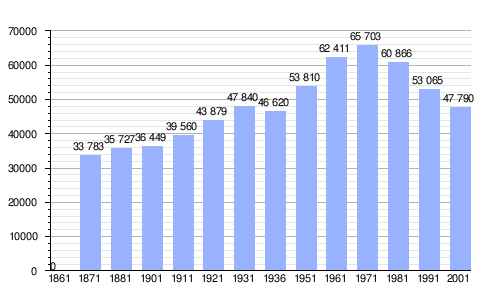 |
Source ISTAT - Wikipedia graphics |
Twinned cities
- Nevers (France, since 1959)
- Charleville-Mézières (France, since 1959)
- Pushkin (Russia, since 1993)
- Weingarten (Germany, since 1998)
- Madison, United States, since 2001
- Omihachiman (Japan, since 2005)
- Oradea (Romania, 2005)
- Vitória (Brazil)
- Casale Monferrato (Italy, since 2010)
- Giulianova (Italy, since 2012)
Notable people
Contenido relacionado
Creole
22nd century BC c.
Panfilo de Narvaez

